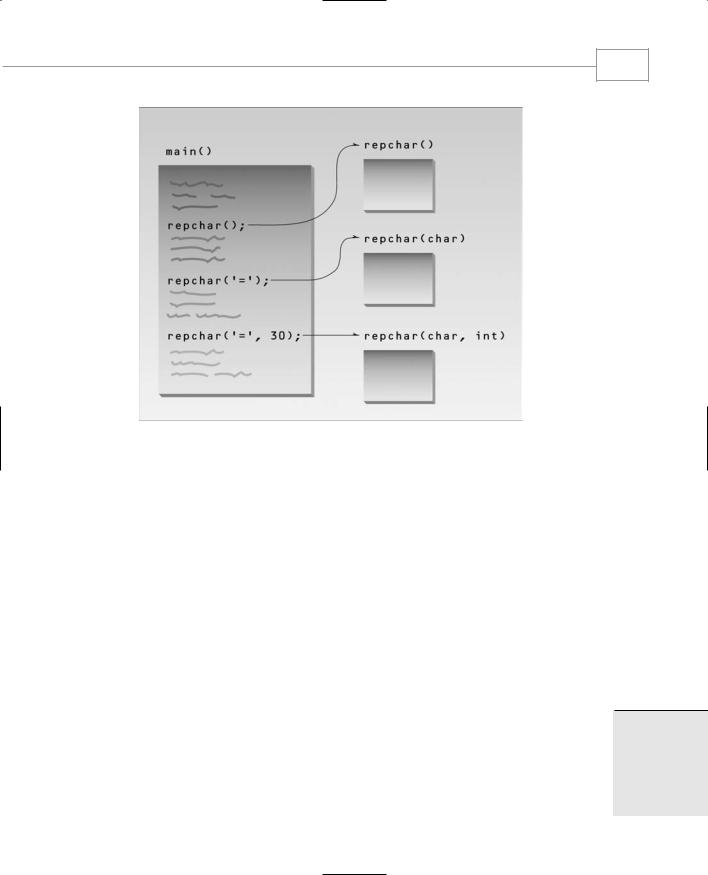
lafore_robert_objectoriented_programming_in_c
.pdf
Functions
The ampersand is not used in the function call:
intfrac(number, intpart, fracpart); |
// no ampersands |
From the function call alone, there’s no way to tell whether an argument will be passed by reference or by value.
While intpart and fracpart are passed by reference, the variable number is passed by value. intp and intpart are different names for the same place in memory, as are fracp and fracpart. On the other hand, since it is passed by value, the parameter n in intfrac() is a separate variable into which the value of number is copied. It can be passed by value because the intfrac() function doesn’t need to modify number.
(C programmers should not confuse the ampersand that is used to mean reference to with the same symbol used to mean address of. These are different usages. We’ll discuss the address of meaning of & in Chapter 10, “Pointers.”)
A More Complex Pass by Reference
Here’s a somewhat more complex example of passing simple arguments by reference. Suppose you have pairs of numbers in your program and you want to be sure that the smaller one always precedes the larger one. To do this you call a function, order(), which checks two numbers passed to it by reference and swaps the originals if the first is larger than the second. Here’s the listing for REFORDER:
//reforder.cpp
//orders two arguments passed by reference #include <iostream>
using namespace std;
int main() |
|
{ |
|
void order(int&, int&); |
//prototype |
int n1=99, n2=11; |
//this pair not ordered |
int n3=22, n4=88; |
//this pair ordered |
order(n1, n2); |
//order each pair of numbers |
order(n3, n4); |
|
cout << “n1=” << n1 << endl; |
//print out all numbers |
cout << “n2=” << n2 << endl; |
|
cout << “n3=” << n3 << endl; |
|
cout << “n4=” << n4 << endl; |
|
return 0; |
|
} |
|
185
5
FUNCTIONS

186 |
Chapter 5 |
|
//-------------------------------------------------------------- |
|
void order(int& numb1, int& numb2) |
//orders two numbers |
{ |
|
if(numb1 > numb2) |
//if 1st larger than 2nd, |
{ |
|
int temp = numb1; |
//swap them |
numb1 = numb2; |
|
numb2 = temp; |
|
} |
|
} |
|
In main() there are two pairs of numbers—the first pair is not ordered and the second pair is ordered. The order() function is called once for each pair, and then all the numbers are printed out. The output reveals that the first pair has been swapped while the second pair hasn’t. Here it is:
n1=11
n2=99
n3=22
n4=88
In the order() function the first variable is called numb1 and the second is numb2. If numb1 is greater than numb2 the function stores numb1 in temp, puts numb2 in numb1, and finally puts temp back in numb2. Remember that numb1 and numb2 are simply different names for whatever arguments were passed; in this case, n1 and n2 on the first call to the function, and n2 and n3 on the second call. The effect is to check the ordering of the original arguments in the calling program and swap them if necessary.
Using reference arguments in this way is a sort of remote-control operation. The calling program tells the function what variables in the calling program to operate on, and the function modifies these variables without ever knowing their real names. It’s as if you called the house painters and, although they never left their office, you sat back and watched as your dining room walls mysteriously changed color.
Passing Structures by Reference
You can pass structures by reference just as you can simple data types. Here’s a program, REFERST, that performs scale conversions on values of type Distance. A scale conversion involves multiplying a group of distances by a factor. If a distance is 6'–8'', and a scale factor is 0.5, the new distance is 3'–4''. Such a conversion might be applied to all the dimensions of a building to make the building shrink but remain in proportion.
//referst.cpp
//demonstrates passing structure by reference #include <iostream>

Functions
187
using namespace std;
////////////////////////////////////////////////////////////////
struct Distance |
//English distance |
{ |
|
int feet; |
|
float inches; |
|
}; |
|
////////////////////////////////////////////////////////////////
void scale( Distance&, float ); |
//function |
|
void engldisp( Distance ); |
//declarations |
|
int main() |
|
|
{ |
|
|
Distance d1 = { |
12, 6.5 }; |
//initialize d1 and d2 |
Distance d2 = { |
10, 5.5 }; |
|
cout << “d1 = “; engldisp(d1); |
//display old d1 and d2 |
|
cout << “\nd2 = |
“; engldisp(d2); |
|
scale(d1, 0.5); |
|
//scale d1 and d2 |
scale(d2, 0.25); |
|
|
cout << “\nd1 = |
“; engldisp(d1); |
//display new d1 and d2 |
cout << “\nd2 = |
“; engldisp(d2); |
|
cout << endl; |
|
|
return 0; |
|
|
} |
|
|
//-------------------------------------------------------------- |
|
|
//scale()
//scales value of type Distance by factor void scale( Distance& dd, float factor)
{
float inches = (dd.feet*12 + dd.inches) * factor; dd.feet = static_cast<int>(inches / 12); dd.inches = inches - dd.feet * 12;
}
//--------------------------------------------------------------
//engldisp()
//display structure of type Distance in feet and inches
void engldisp( Distance dd ) |
//parameter dd of type Distance |
|
{ |
5 |
|
cout << dd.feet << “\’-” << |
dd.inches << “\””; |
|
} |
|
|
FUNCTIONS

Chapter 5
188
REFERST initializes two Distance variables—d1 and d2—to specific values, and displays them. Then it calls the scale() function to multiply d1 by 0.5 and d2 by 0.25. Finally, it displays the resulting values of the distances. Here’s the program’s output:
d1 = 12’-6.5”
d2 = 10’-5.5”
d1 = 6’-3.25”
d2 = 2’-7.375”
Here are the two calls to the function scale():
scale(d1, 0.5); scale(d2, 0.25);
The first call causes d1 to be multiplied by 0.5 and the second causes d2 to be multiplied by 0.25. Notice that these changes take place directly to d1 and d2. The function doesn’t return anything; the operation is performed directly on the Distance argument, which is passed by reference to scale(). (Since only one value is changed in the calling program, you could rewrite the function to pass the argument by value and return the scaled value. Calling such a function would look like this:
d1 = scale(d1, 0.5);
However, this is unnecessarily verbose.)
Notes on Passing by Reference
References don’t exist in C, where pointers serve a somewhat similar purpose, although often less conveniently. Reference arguments were introduced into C++ to provide flexibility in a variety of situations involving objects as well as simple variables.
The third way to pass arguments to functions, besides by value and by reference, is to use pointers. We’ll explore this in Chapter 10.
Overloaded Functions
An overloaded function appears to perform different activities depending on the kind of data sent to it. Overloading is like the joke about the famous scientist who insisted that the thermos bottle was the greatest invention of all time. Why? “It’s a miracle device,” he said. “It keeps hot things hot, but cold things it keeps cold. How does it know?”
It may seem equally mysterious how an overloaded function knows what to do. It performs one operation on one kind of data but another operation on a different kind. Let’s clarify matters with some examples.

Functions
189
Different Numbers of Arguments
Recall the starline() function in the TABLE example and the repchar() function from the TABLEARG example, both shown earlier in this chapter. The starline() function printed a line using 45 asterisks, while repchar() used a character and a line length that were both specified when the function was called. We might imagine a third function, charline(), that always prints 45 characters but that allows the calling program to specify the character to be printed. These three functions—starline(), repchar(), and charline()—perform similar activities but have different names. For programmers using these functions, that means three names to remember and three places to look them up if they are listed alphabetically in an application’s
Function Reference documentation.
It would be far more convenient to use the same name for all three functions, even though they each have different arguments. Here’s a program, OVERLOAD, that makes this possible:
//overload.cpp
//demonstrates function overloading #include <iostream>
using namespace std;
void repchar(); |
//declarations |
|
void |
repchar(char); |
|
void |
repchar(char, int); |
|
int main()
{
repchar();
repchar(‘=’); repchar(‘+’, 30); return 0;
}
//--------------------------------------------------------------
//repchar()
//displays 45 asterisks void repchar()
{
for(int j=0; j<45; j++) // always loops 45 times
cout << ‘*’; |
// always prints asterisk |
cout << endl; |
|
} |
|
//-------------------------------------------------------------- |
|
//repchar()
//displays 45 copies of specified character void repchar(char ch)
{
for(int j=0; j<45; j++) // always loops 45 times
cout << ch; |
// prints specified character |
5
FUNCTIONS

190 |
Chapter 5 |
|
cout << endl;
}
//--------------------------------------------------------------
//repchar()
//displays specified number of copies of specified character void repchar(char ch, int n)
{
for(int |
j=0; j<n; j++) |
// |
loops n times |
cout |
<< ch; |
// |
prints specified character |
cout << |
endl; |
|
|
} |
|
|
|
This program prints out three lines of characters. Here’s the output:
*********************************************
=============================================
++++++++++++++++++++++++++++++
The first two lines are 45 characters long, and the third is 30.
The program contains three functions with the same name. There are three declarations, three function calls, and three function definitions. What keeps the compiler from becoming hopelessly confused? It uses the function signature—the number of arguments, and their data types—to distinguish one function from another. In other words, the declaration
void repchar();
which takes no arguments, describes an entirely different function than the declaration
void repchar(char);
which takes one argument of type char, or the declaration
void repchar(char, int);
which takes one argument of type char and another of type int.
The compiler, seeing several functions with the same name but different numbers of arguments, could decide the programmer had made a mistake (which is what it would do in C). Instead, it very tolerantly sets up a separate function for every such definition. Which one of these functions will be called depends on the number of arguments supplied in the call. Figure 5.8 shows this process.

Functions
191
FIGURE 5.8
Overloaded functions.
Different Kinds of Arguments
In the OVERLOAD example we created several functions with the same name but different numbers of arguments. The compiler can also distinguish between overloaded functions with the same number of arguments, provided their type is different. Here’s a program, OVERENGL, that uses an overloaded function to display a quantity in feet-and-inches format. The single argument to the function can be either a structure of type Distance (as used in the ENGLDISP example) or a simple variable of type float. Different functions are used depending on the type of argument.
//overengl.cpp
//demonstrates overloaded functions #include <iostream>
using namespace std;
////////////////////////////////////////////////////////////////
struct Distance |
//English distance |
{ |
|
int feet; |
|
float inches; |
|
}; |
|
////////////////////////////////////////////////////////////////
5
FUNCTIONS

192
void engldisp( Distance ); |
//declarations |
|
void engldisp( float ); |
|
|
int main() |
|
|
{ |
|
|
Distance d1; |
//distance of type Distance |
|
float d2; |
//distance of type float |
|
|
|
//get length d1 from user |
cout << |
“\nEnter feet: “; |
cin >> d1.feet; |
cout << |
“Enter inches: “; |
cin >> d1.inches; |
|
|
//get length d2 from user |
cout << |
“Enter entire distance in inches: “; cin >> d2; |
|
cout << |
“\nd1 = “; |
|
engldisp(d1); |
//display length 1 |
|
cout << |
“\nd2 = “; |
|
engldisp(d2); |
//display length 2 |
|
cout << |
endl; |
|
return 0; |
|
|
} |
|
|
//-------------------------------------------------------------- |
|
|
//engldisp()
//display structure of type Distance in feet and inches
void engldisp( Distance dd ) //parameter dd of type Distance
{
cout << dd.feet << “\’-” << dd.inches << “\””;
}
//--------------------------------------------------------------
//engldisp()
//display variable of type float in feet and inches
void engldisp( float dd ) //parameter dd of type float
{
int feet = static_cast<int>(dd / 12); float inches = dd - feet*12;
cout << feet << “\’-” << inches << “\””;
}
The user is invited to enter two distances, the first with separate feet and inches inputs, the second with a single large number for inches (109.5 inches, for example, instead of 9'–1.5''). The program calls the overloaded function engldisp() to display a value of type Distance for the first distance and of type float for the second. Here’s some sample interaction with the program:
Enter feet: 5 Enter inches: 10.5
Enter entire distance in inches: 76.5 d1 = 5’-10.5”
d2 = 6’-4.5”

Functions
193
Notice that, while the different versions of engldisp() do similar things, the code is quite different. The version that accepts the all-inches input has to convert to feet and inches before displaying the result.
Overloaded functions can simplify the programmer’s life by reducing the number of function names to be remembered. As an example of the complexity that arises when overloading is not used, consider the C++ library routines for finding the absolute value of a number. Because these routines must work with C (which does not allow overloading) as well as with C++, there must be separate versions of the absolute value routine for each data type. There are four of them: abs() for type int, cabs() for complex numbers, fabs() for type double, and labs() for type long. In C++, a single name, abs(), would suffice for all these data types.
As we’ll see later, overloaded functions are also useful for handling different types of objects.
Recursion
The existence of functions makes possible a programming technique called recursion. Recursion involves a function calling itself. This sounds rather improbable, and indeed a function calling itself is often a bug. However, when used correctly this technique can be surprisingly powerful.
Recursion is much easier to understand with an example than with lengthy explanations, so let’s apply it to a program we’ve seen before: the FACTOR program of Chapter 3, “Loops and Decisions.” That program used a for loop to calculate the factorial of a number. (See that example for an explanation of factorials.) Our new program, FACTOR2, uses recursion instead of a loop.
//factor2.cpp
//calculates factorials using recursion #include <iostream>
using namespace std;
unsigned long factfunc(unsigned long); //declaration
int main() |
|
{ |
|
int n; |
//number entered by user |
unsigned long fact; //factorial |
|
cout << “Enter an integer: “; |
|
cin >> |
n; |
fact = |
factfunc(n); |
cout << “Factorial of “ << n << “ is “ << fact << endl; |
|
return |
0; |
} |
|
5
FUNCTIONS

Chapter 5
194
//-------------------------------------------------------------
//factfunc()
//calls itself to calculate factorials unsigned long factfunc(unsigned long n)
{
if(n > 1)
return n * factfunc(n-1); //self call else
return 1;
}
The output of this program is the same as the FACTOR program in Chapter 3.
The main() part of FACTOR2 looks reasonable: it calls a function, factfunc(), with an argument that is a number entered by the user. This function then returns the factorial of that number to main().
The function factfunc() is another story. What’s it doing? If n is greater than 1, the function calls itself. Notice that when it does this it uses an argument one less than the argument it was called with. Suppose it was called from main() with an argument of 5. It will call a second version of itself with an argument of 4. Then this function will call a third version with an argument of 3, and so on.
Notice that each version of the function stores its own value of n while it’s busy calling another version of itself.
After factfunc() calls itself four times, the fifth version of the function is called with an argument of 1. It discovers this with the if statement, and instead of calling itself, as previous versions have, it returns 1 to the fourth version. The fourth version has stored a value of 2, so it multiplies the stored 2 by the returned 1, and returns 2 to the third version. The third version has stored 3, so it multiplies 3 by the returned 2, and returns 6 to the second version. The second version has stored 4, so it multiplies this by the returned 6 and returns 24 to the first version. The first version has stored 5, so it multiplies this by the returned 24 and returns 120 to main().
Thus in this example we have five function calls followed by five function returns. Here’s a summary of this process:
|
|
Argument or |
Version |
Action |
Return Value |
|
|
|
1 |
Call |
5 |
2 |
Call |
4 |
3 |
Call |
3 |
4 |
Call |
2 |
